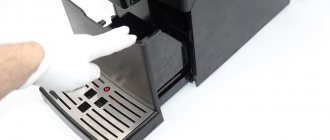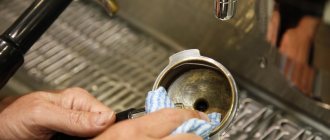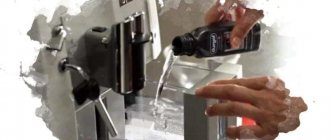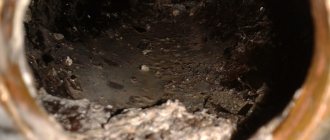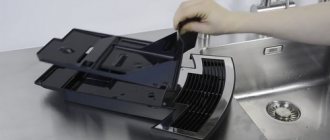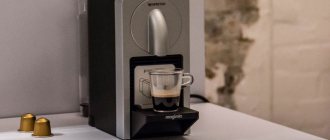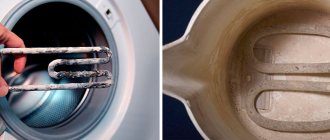Almost every person has had to deal with problems associated with the formation of scale: over time, a dense limescale deposit appears on the heating elements of washing machines, electric kettles and other household appliances .
Even the most modern models of coffee machines, equipped with various sensors for monitoring water quality, are also susceptible to the negative effects of hardness salts and require regular descaling procedures.
How do you know when it's time?
The main signs of scale formation on the internal elements of the unit are the appearance of an unpleasant, musty odor and a deterioration in the taste of the drink (even if the proportions of the ingredients are strictly observed during the brewing process, the coffee turns out to be insufficiently strong and tasteless). The following may also indicate the formation of hardness salt deposits on the heating elements of the machine:
- humming, changes in the sound of the device’s electric motor, the appearance of extraneous noise;
- a significant drop in steam pressure during the preparation of the drink;
- the presence of tiny white flakes in brewed coffee.
Do you use your coffee machine often?
Not really
Many modern machines are equipped with special sensors with light indicators displayed on the unit panel, which after a certain time inform the owner of the electrical appliance that it is time to decalcify.
IMPORTANT! The correct operation of the sensors depends on the correct setting of water hardness indicators in the device settings: the higher the content of magnesium and calcium salts in the liquid used for brewing coffee, the more often decalcification should be carried out.
Causes of scale formation
Many people assume that scale is formed due to the fact that low-quality water is used, but this is an incorrect assumption. Pure, filtered water contains many microelements such as calcium, potassium, magnesium, chloride, and iron. When heated, their compounds form a limescale deposit, which is familiar to everyone. If you do not systematically descale the coffee machine, this “disease” will progress, forming corrosion of the internal parts of the machine. In addition, the porous texture of scale is an ideal environment for the development of bacteria.
Many modern devices have built-in scale control sensors, but if the model does not have this function, then there are several ways to check whether it’s time to descale. Firstly, the taste of your usual coffee changes. Secondly, the smell of the drink takes on a musty tinge. Third, you will notice a decrease in steam pressure. Fourthly, the strength of the drink will decrease and, finally, the coffee machine will begin to make unusual noises during operation.
Why rinse?
Limescale, accumulating inside the tanks and on the heating elements of the device in contact with water, forms a “fur coat” on the machine components, which creates thermal resistance and significantly impairs the thermal conductivity of the metal.
This undesirable thermal insulation leads to additional load on the electric heater, an increase in the amount of time required to prepare coffee, corrosion of the device elements and wear of parts.
Read step-by-step instructions on how to clean your coffee machine yourself.
A piece of scale that has formed can break off and damage the machine by blocking the liquid injection system into the coffee.
It should be remembered that in addition to premature breakdown of the unit, deposits of hardness salts can also be harmful to human health : plaque has a porous structure and is a favorable environment for the habitat and reproduction of many bacteria, including pathogens.
Why this remedy?
Tribasic carboxylic acid is a water-soluble crystalline substance. As a result of the chemical interaction of this product with scale, a new compound is formed - sodium salt, which can be easily removed from the walls and components of the machine by regular washing.
Citric acid can effectively remove even old, stubborn lime deposits, is safe to use, does not emit toxic fumes and is absolutely harmless to human health and the environment.
Citric acid can also be used to clean a microwave, see this article for details.
REFERENCE! An important advantage of this product over chemicals sold in stores is its availability and low cost.
How much substance do we need?
Many people mistakenly believe that in order to efficiently and quickly get rid of plaque in a coffee machine, it is necessary to add as much acidic powder to the unit as possible: too concentrated a product can cause damage to the functional components of the device. Therefore, when preparing the solution, follow the recommended proportions of acid and water:
- for regular cleaning of the unit, you will need 30 g of crystalline substance per 1 liter of water;
- if the device has been decalcified for a long time, the product can be made more concentrated by increasing the amount of acid to 50 g
Observe the proportions and prepare the solution
To prepare the cleaning product, prepare water (the amount of liquid depends on the specific model of the machine; information about this can be found in the instructions for the household appliance) and citric acid.
Heat the water to room temperature, then add the sour powder into it and stir it thoroughly.
The same solution is suitable for cleaning a dishwasher with citric acid.
Is it possible to clean a Delonghi coffee machine with citric acid?
The model of this manufacturer is popular. This is due to the ease of operation, convenience and reliability of household appliances.
The manufacturer produces coffee machines both with a self-cleaning system and without this function. In the absence of a regime and using ordinary water, it is necessary to promptly remove the resulting limescale deposits.
You can clean the electrical appliance using special purchased household chemicals. They were developed by coffee machine manufacturer Delonghi. The most inexpensive method is cleaning with citric acid.
Thanks to the safety of the powder, you can use it to clean plaque
Instructions
As a rule, decalcification lasts 30-40 minutes and includes the following steps:
- removal of lime deposits;
- first rinse;
- second rinse.
Procedure:
- unplug the device from the socket;
- remove the liquid reservoir from the machine and rinse it several times with running water;
- pour the pre-prepared citric acid solution into the container, place the container in the apparatus;
- Connect the device to the power supply and start automatic cleaning. If your machine does not have this feature, leave the acid on the sides of the container for 20 minutes, then press the coffee button (without putting beans into the unit) and repeat the process until all the cleaning agent has been used up.
- Turn off the power to the appliance again, remove and rinse the liquid container. Carefully inspect the walls of the tank: if there are traces of scale on them, repeat the decalcification procedure 1-2 more times.
- Fill the unit container with clean water to the maximum allowable level and start the brewing mode.
- Repeat the rinsing step of the coffee machine again.
IMPORTANT! Depending on the degree of water hardness in the region where you live, it is advisable to clean the electrical appliance at least once every 3-6 months (every 150-250 servings of drink).
Automatic cleaning and washing of device parts
How to clean a machine that has the Auto Clean function built-in? Each coffee brewing unit has its own set of functions; it is ideal to purchase a machine with auto-cleaning. Naturally, the coffee machine should come with an instruction manual that describes how to start automatic cleaning. But if for some reason the annotation is missing, then this should be done as follows:
- 1 First, you need to empty the container and cleaner from the coffee.
- 2 Next, you need to pour water into the container and add anti-scale agent into it.
- 3 Then you need to start auto cleaning and watch the indicator.
- 4 Once 10 minutes have passed, you need to place the vessel and turn the spout through which steam is released to the right; the reddish indicator will light up.
- 5 Wash the tray to remove any drips, refill with water and place the container. Only this time the faucet must be turned to the left, thanks to which the internal cleaning of the system will be performed.
- 6 Wait until all the indicators light up, and this will signal that the coffee machine has been successfully cleaned.
This auto-cleaning should be done infrequently, but systematically. We must not forget about washing the body, drip tray, cappuccino maker and waste container.
It is not difficult to clean all the listed components; the body can be wiped with a cloth, and trays and containers must be washed under running water to remove dirt. It is recommended to place the cappuccino maker in a container with clean water and start the steam supply. As soon as untainted water flows, the cleaning is completed.
Alternative methods
available means will also help effectively deal with limescale stains in the unit . The algorithm for their use is similar to the use of citric acid.
Vinegar
To clean the walls of the tank and the heating elements of the device, you will need table vinegar: filling the unit with acetic acid or essence is unacceptable, as this can lead to damage to the device.
To prepare the product yourself, dilute the acidic liquid with warm water in a 1:2 ratio.
Cleaning procedure:
- disconnect the device from the power supply, remove and thoroughly rinse the liquid container;
- fill the reservoir with the prepared cleaning product;
- turn on the machine, wait for the water to boil, turn off the unit, remove the power plug from the socket;
- leave the device filled with liquid and vinegar for 8-10 hours;
- After the time has passed, drain the solution and rinse the container several times with clean water.
ATTENTION! After using vinegar, a pungent, specific odor often remains in the car. To eliminate the unpleasant aroma and sour taste, brew 2-3 cups of the drink and pour them out.
You can also clean the microwave using vinegar and soda, read more here.
Soda and salt
Another common way to remove plaque using home remedies is to use a soda-salt solution . This method is suitable for regular cleaning of household appliances and does an excellent job of removing a small layer of scale.
To remove lime deposits, follow these steps:
- dissolve soda and salt in warm water (at the rate of 1 teaspoon of sodium bicarbonate and sodium chloride per 1 liter of liquid), mix the components until all the crystals dissolve;
- pour the product into the tank of the machine and leave it to act on the scale (there is no need to turn on the device and heat the water);
- After 4 hours, pour the solution out of the container and rinse the coffee maker.
ATTENTION! To prevent the smallest particles of salt or soda remaining in the device from getting into the drink during the brewing process, after cleaning, turn on the unit, make 1-2 cups of coffee, which then pour it out.
Store-bought cleaning products
Home remedies undoubtedly have many advantages: low cost, ease of preparation of solutions and accessibility. But if they are used, there is a risk of making the drug too concentrated, which can harm the equipment.
The special products recommended by coffee machine manufacturers are absolutely safe for the machine , despite the relatively high cost.
Depending on the form of release, all industrial drugs can be divided into two groups:
- tableted;
- liquid.
As a rule, decalcinators very quickly and effectively remove even a thick layer of scale , as they are made on the basis of chemically active substances (acids).
If you have a Nespresso coffee machine, read the cleaning instructions here.
Liquid products are ready for use - just pour the amount of the drug specified in the instructions for the machine into the tank and perform cleaning:
- If the machine is not equipped with an automatic descaling program, fill the container with decalcifier and 1 liter of warm water. Turn on the unit, pour 2 cups of liquid through the hot water supply tube, turn off the machine, leaving the hot water control knob in the open position. After 5 minutes, start the drink preparation program. The first 2-3 cups of liquid are undrinkable and must be thrown away.
- If the unit has an automatic cleaning function, fill the reservoir with a special product, pour in 1 liter of water, close the hot liquid control knob and prepare 2 cups of drink along with the chemical, pour them out, turn on the automatic descaling cycle.
In terms of their composition, tablet products have minor differences from liquid ones; they also contain acid. Before starting the procedure, the tablet is dissolved in a certain amount of water (the proportions of the solution are indicated on the packaging of the cleaning product).
ATTENTION! After using chemicals, be sure to remove the liquid container from the device and rinse it several times with clean water.
Removing coffee oils
Coffee oils (aka fats) are another “eternal” problem with all coffee machines. They accumulate in the brewing unit filter, which is an oval plate with holes.
Special Pill
To get rid of deposits, use a special cleaning pill and the cleaning function, which is available in most models of coffee machines:
You place the cleaning pill in the ground coffee compartment, which leads to the brewing unit. If your unit does not have such a compartment, place the cleaning product directly on the perforated filter plate. Remember: the pill cannot be placed in the aqua container.
Next, the coffee machine will take over. Watch the color of the water that comes out in the coffee serving area. If everything goes well and the pill dissolves the coffee oils, a whitish soapy liquid will come out.
Soap solution
If your coffee machine does not have an automatic cleaning function for coffee oils, then you will have to remove them manually with a soapy substance. For this:
Pull out the filter of the brewing unit.
Apply a soap solution to the surface with oil deposits. You start using a brush with soft bristles.
Finally, rinse thoroughly with running water.
Do not clean the filter holes with a needle under any circumstances, otherwise they will expand and the espresso and cappuccino will brew worse.
Let's sum it up
Carry out the descaling procedure regularly , without waiting for your machine to signal the need for descaling. The sensors installed in it do not monitor the degree of contamination, but only control the number of cups of coffee prepared. Therefore, even if the equipment does not “ask” for cleaning, this does not mean that limescale has not formed on its heating elements.
To eliminate hardness salts, use special preparations in the form of tablets, liquids, or homemade products based on citric acid, vinegar, soda and salt.
Before using professional decalcifiers or traditional methods, be sure to carefully read the operating instructions for coffee equipment and strictly follow all proportions of components when preparing solutions.
ATTENTION! It is also undesirable to clean the device with solid or liquid soap: coffee brewed after cleaning will have an unpleasant soapy taste and aroma for a long time.
Useful tips
Proper operation and proper care of the coffee machine is a guarantee of long-term operation. Clean your appliance's major systems regularly and you'll be enjoying fresh coffee for years to come.
Basic rules of care:
- Make sure that the equipment is always dry and immediately remove moisture with a napkin.
- Change the filter promptly.
- Wipe off spilled coffee from the auto-heating stove; it will retain heat longer.
- Clean the container of any remaining coffee grounds and milk so that the sour smell does not spoil the taste of the coffee.
- Descale in a timely manner.
Professional or folk remedies will remove residual milk, coffee fats, and limescale. It is important to do this regularly, following the instructions.
To make caring for your coffee machine easier, prevention is necessary. Use clean, soft water, bottled or filtered, to make coffee. Water that has undergone double purification (the first - using a household device, and the second - directly in the coffee machine) causes the formation of limescale to a lesser extent, and decalcification is required much less frequently. If you follow all these rules, breakdown of coffee equipment is practically impossible.
Pollution prevention
One of the main ways to significantly reduce the number of descaling procedures is to use low-hardness water for brewing coffee: bottled or purified . At the same time, do not forget to make changes to the water hardness settings: if programming is incorrect, the unit will often (or too rarely) “demand” decalcification.
The use of soft water is also effective for equipment with built-in filters: often the power of the cleaning element installed by the manufacturer is not enough to protect the functional components of the device from lime deposits.
Regardless of the configuration and functionality of the coffee machine, decalcify the household appliance using traditional methods or special means at least once a year . Compliance with this rule will ensure long-term uninterrupted operation of your device and significantly extend its service life.
Precautionary measures
Before cleaning the coffee machine, you must read the manufacturer's instructions, which indicate the frequency of the decalcification process. When cleaning the unit, all safety precautions should be observed:
- Before carrying out the procedure, you must disconnect the device from the power supply;
- For cleaning, use only products approved by the manufacturer;
- do not use concentrated solutions that may adversely affect the operation of internal elements;
- Avoid getting water on the internal parts of the coffee machine so that a short circuit does not occur after turning it on.
